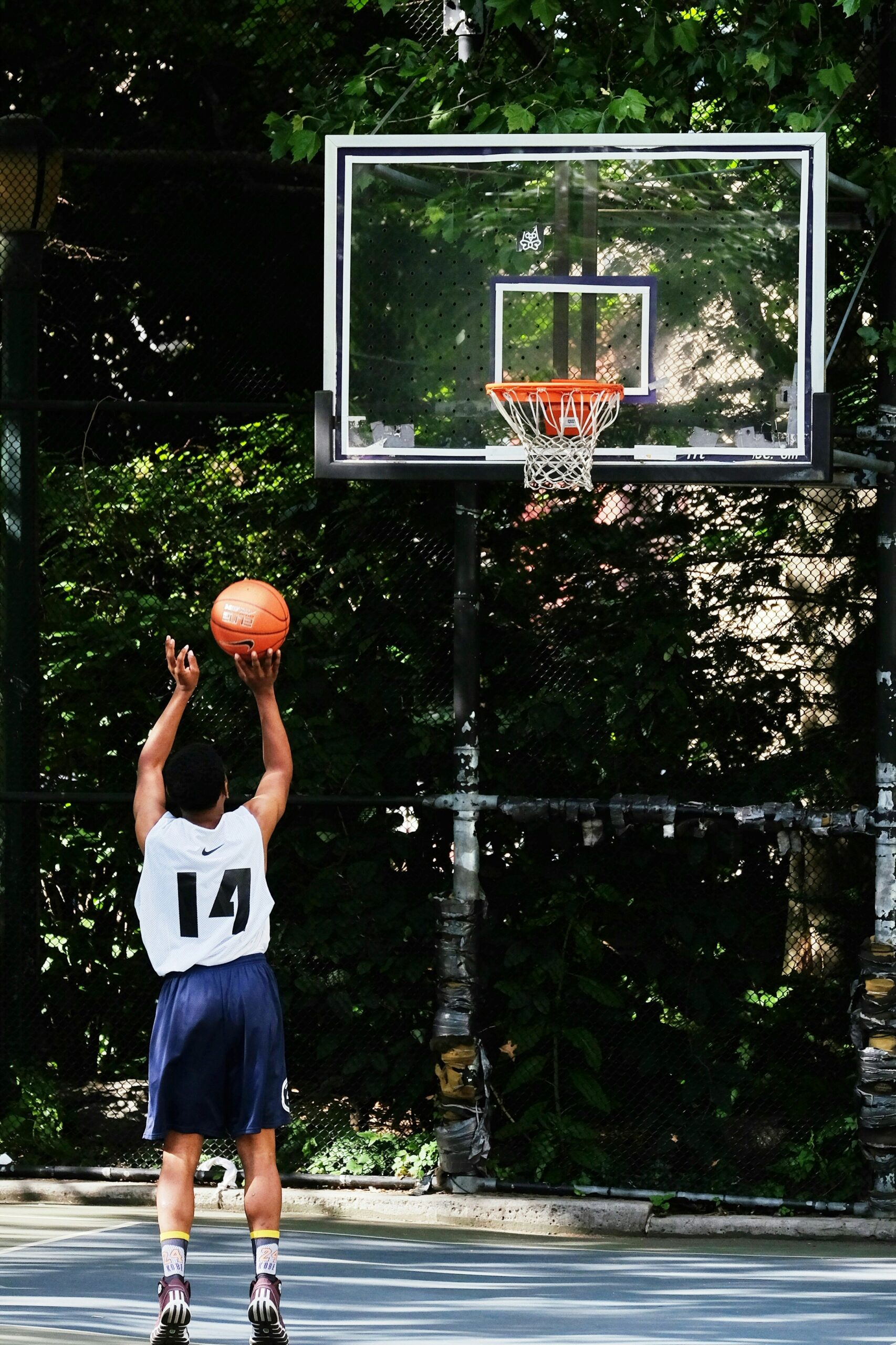What is Basketball?
Basketball is a dynamic team sport that combines athleticism, strategy, and skill. Originating in December 1891, when Dr. James Naismith, a physical education instructor, sought to create an indoor game to engage his students during winter, basketball has evolved into a globally popular sport. Initially played with a peach basket and a soccer ball, the game quickly transformed as rules and equipment became standardized. Today, it features two teams of five players each, who aim to score points by shooting a ball through the opponent’s hoop.
The fundamental objective of basketball is straightforward: score more points than the opposing team. Points are scored by making field goals, worth two or three points depending on the shooting distance, or free throws, which are worth one point. Each game consists of four quarters, with a clock that regulates playtime, making time management an essential aspect of strategy. The game’s basic rules dictate personal fouls, violations like traveling or double dribbling, and the offside rule, which ensures fair play and order on the court.
To play basketball effectively, certain equipment is necessary. The most critical component is the basketball itself, which is designed for grip and bounce. The hoops, positioned at a height of 10 feet, consist of a metal rim and a net. Additionally, the playing surface, known as the basketball court, measures 94 by 50 feet at the professional level, complete with markings that define critical areas, including the three-point and free-throw lines. For players, appropriate athletic footwear is important for performance and safety while navigating the court.
In summary, basketball is a sport steeped in history and rich in community engagement. Understanding its origins, fundamental rules, and necessary equipment serves as a solid foundation for anyone looking to learn more about the game and its intricate strategies.
The Fundamental Skills Required in Basketball
Basketball is a dynamic and multifaceted sport that demands a variety of fundamental skills for success. Players must master several essential techniques, including dribbling, shooting, passing, and defense, each contributing uniquely to overall gameplay. Fostering these skills through practice and drill work can significantly enhance a player’s performance on the court.
Dribbling is one of the core skills necessary in basketball. Effective dribbling allows players to navigate the court while maintaining possession of the ball. To improve dribbling, players should practice exercises such as the “Zig-Zag Dribble,” where they weave through cones, thereby developing both control and agility. Additionally, mastering crossover dribbles, between-the-legs, and behind-the-back moves can prepare a player for more challenging game scenarios.
Shooting proficiency is another critical aspect of basketball. Players must develop proper shooting form to increase their chances of scoring. Regular practice of shooting drills, such as “Spot Shooting,” where players take shots from designated spots on the court, helps in refining accuracy and consistency. Additionally, incorporating free-throw shooting into training routines is vital, as it assists players in improving their focus and poise under pressure.
Passing is equally essential, as effective ball movement enables teams to create scoring opportunities. Players should practice various passing techniques, including chest passes, bounce passes, and overhead passes, while incorporating drills that simulate game situations like the “Three-Man Weave.” This exercise enhances teamwork and develops timing and spacing on the court.
Lastly, defense cannot be overlooked, as it is crucial for preventing opponents from scoring. Players should focus on improving their defensive stance, lateral movement, and awareness. Drills like “One-on-One Defense” help players learn to anticipate and react to offensive moves, thereby honing their defensive skills.
In conclusion, mastering the fundamental skills of dribbling, shooting, passing, and defense is paramount for any aspiring basketball player. Through dedicated practice and targeted drills, players can develop these core competencies, significantly contributing to their overall effectiveness in the game.
The Importance of Physical Conditioning
Basketball is an incredibly dynamic sport that necessitates a high level of physical conditioning. The game’s fast-paced nature requires players to exhibit a combination of strength, agility, endurance, and flexibility. Each of these components plays a critical role in enhancing on-court performance and mitigating the risk of injury. For aspiring basketball players, particularly at competitive levels, physical conditioning is not merely an option; it is essential.
Strength training is fundamental for developing the power needed for explosive movements such as jumping and sprinting. Incorporating exercises like squats, lunges, and deadlifts can significantly improve leg strength and overall muscle stability. Additionally, upper body strength plays a vital role in shooting accuracy and the ability to battle through physical confrontations during the game. Resistance training should thus be part of an athlete’s regular workout regimen, helping to build vital muscle groups that contribute to performance.
Agility training is another cornerstone of basketball conditioning, as players are required to change direction swiftly and efficiently. Drills that incorporate cone workouts, ladder drills, and short sprints can greatly enhance foot speed and coordination, making players more effective in both defense and offense. Similarly, endurance training is crucial as it allows players to maintain their energy levels throughout the game. High-Intensity Interval Training (HIIT) and gradual distance running can be beneficial for improving cardiovascular fitness.
Lastly, flexibility cannot be overlooked. Stretching routines should be a staple in every basketball player’s routine, as increased flexibility can lead to better performance and reduced injury risk. Dynamic stretches before games and static stretches after workouts are effective ways to promote muscle flexibility. Thus, adopting a well-rounded physical conditioning program, which includes strength training, agility drills, endurance activities, and flexibility exercises, is indispensable for success in basketball.
Understanding Basketball Strategies and Tactics
Basketball is a multifaceted sport that demands a deep understanding of various strategies and tactics to be successful. Central to the game are offensive and defensive plays, which serve to either secure points or prevent the opponent from scoring. The ability to develop and implement effective strategies can significantly influence the outcome of a game.
Offensive strategies involve the systematic movement of players and the ball to create scoring opportunities. Common offensive formations include the pick-and-roll, isolation plays, and motion offenses. The pick-and-roll, for instance, allows a player with the ball to use a teammate as a screen, effectively creating space to either drive towards the basket or take an open shot. Mastering these plays enables players to exploit defensive weaknesses, ultimately enhancing their scoring efficiency.
On the defensive front, teams often adopt various formations such as man-to-man defense or zone defense. Man-to-man defense requires each player to guard a specific opponent, promoting a higher level of individual responsibility. In contrast, zone defense involves players guarding specific areas of the court, aiming to defend against multiple offensive threats simultaneously. Understanding when to use these defensive tactics provides players with strategic advantages, enabling them to counteract the offensive strategies employed by their opponents.
The integration of game strategies into practice allows players to develop their game intelligence. This promotes quick decision-making during matches and fosters an ability to adapt to the opposing team’s tactics. It is essential for players to study and analyze game footage, identifying successful plays and areas for improvement. By familiarizing themselves with the intricacies of basketball strategies, players can elevate their overall performance while contributing to a collective team effort. Developing a comprehensive understanding of these strategies is crucial for any player aspiring to excel in basketball.
The Mental Game of Basketball
The mental game of basketball plays a crucial role in determining a player’s success on the court. Mental toughness is essential; it allows athletes to withstand pressure and perform at their best, even in challenging situations. Developing mental resilience involves cultivating a strong belief in one’s abilities, which can significantly impact performance. This aspect of the game is often underestimated, yet it can be the difference between winning and losing.
Focus is another critical component of the mental game. Maintaining concentration during games enables players to execute their skills effectively. Distractions are abundant, from crowd noise to high-stakes environments, and an athlete’s ability to tune out these distractions can significantly enhance their performance. Strategies such as deep breathing can help athletes regain focus during high-pressure moments, ensuring they remain present and ready to execute their plays.
Game awareness, or basketball IQ, is another vital psychological element. Players with high basketball IQ understand the flow of the game, anticipate opponents’ moves, and make tactical decisions more effectively. This cognitive aspect can be developed through extensive study and practice, including watching game films, analyzing plays, and understanding different offensive and defensive strategies. Knowledge of the game contributes to a player’s ability to adapt to varying situations on the court.
Visualization techniques can further enhance mental performance. Athletes often visualize successful plays, allowing them to mentally rehearse scenarios before they occur. This practice not only builds confidence but also prepares players for actual game situations. Goal setting is equally important, as it provides direction and motivation. Establishing both short-term and long-term goals can enhance an athlete’s focus and drive, ensuring they remain committed to their development. Overall, a well-rounded mental approach to basketball can significantly elevate a player’s game and contribute to sustained success on the court.
How to Find Coaching and Learning Resources
Finding effective coaching and learning resources is crucial for anyone wishing to improve their basketball skills. One of the first steps is to identify local basketball leagues and clubs that offer structured training sessions catering to varying skill levels. Community centers and schools often have programs aimed at youth players, providing a nurturing environment for developing foundational skills. Joining these leagues not only provides access to trained coaches but also enables players to engage in regular practice and intra-team competitions, enriching their learning experience.
Clinics and workshops are another excellent avenue for aspiring players. These are often hosted by experienced coaches and former players, providing intensive training sessions that focus on specific aspects of the game, such as shooting techniques, defensive strategies, or teamwork development. Keep an eye out for announcements on local sports websites, community bulletin boards, and social media groups where such events are frequently advertised.
In addition to local resources, the internet offers a wealth of information and instructional materials. Numerous websites and online platforms provide access to training videos, articles written by experts, and interactive tutorials that cover the various elements of basketball. Websites like YouTube feature channels dedicated to basketball training, where one can find detailed demonstrations and drills that can be performed at home or on the court. Online training programs are also available, which may include personalized coaching from certified instructors, thereby allowing players to receive feedback conveniently from anywhere.
Moreover, utilizing social media platforms can connect aspiring players with experienced mentors and coaching networks. Engaging with basketball communities online also provides the opportunity to ask questions, share experiences, and gather tips from seasoned players and coaches alike. By leveraging these local and online resources, players can enhance their basketball knowledge and elevate their skills significantly.
Tips for Practicing and Improving Your Game
Enhancing your basketball skills entails a combination of structured practice, disciplined routines, and continuous self-assessment. To start, establishing a consistent practice schedule is crucial. Allocate specific days and times each week dedicated solely to basketball training. Consistency helps in building muscle memory and improves overall performance on the court. Make sure the schedule is realistic; it should fit seamlessly within your daily commitments to ensure adherence.
Incorporating a variety of drills and workouts into your practice sessions will also benefit your development. Focus on skill-specific drills that target shooting, ball handling, and defensive maneuvers. For instance, practicing free throws and layups enhances shooting discipline, while dribbling drills improve your handling under pressure. Doing these exercises repetitively helps in refining techniques and boosting confidence. Additionally, it is beneficial to include conditioning workouts to enhance your stamina, which is vital in maintaining performance throughout the game.
Tracking your progress is another effective strategy for improvement. Maintain a journal or utilize an app to note the drills performed, goals achieved, and areas where you may struggle. This process not only facilitates mindfulness regarding your growth but also identifies strengths to build on and weaknesses that need attention. Regular evaluations will allow you to celebrate milestones and adjust your training focus as needed.
Moreover, learning is amplified through competing at various levels. Participating in games against players of different skill levels exposes you to diverse playing styles and challenges. It will also stress the importance of adapting your strategy on-the-fly, equipping you with experience that practice alone cannot provide. Prioritizing discipline and consistency in your practice approach will ultimately elevate your basketball skills and enhance your enjoyment of the game.
Joining a Community and Playing with Others
Participating in basketball extends beyond the physicality of the game; it also encompasses a vibrant social element that can significantly enhance one’s experience. Joining a local basketball community, whether through organized leagues or informal pickup games, offers players an opportunity not only to improve their skills but also to build lasting relationships with fellow enthusiasts. Engaging with a group of individuals who share the same passion for the sport fosters a sense of belonging and motivation.
The benefits of playing in a community setting are manifold. Firstly, teamwork is an essential aspect of basketball. Collaborating with others allows players to learn the importance of communication, coordination, and collective strategy, all of which are vital for success on the court. This cooperative spirit nurtures sportsmanship, teaching individuals to support one another, celebrate shared accomplishments, and graciously handle losses. Additionally, playing alongside diverse teammates exposes players to various styles and techniques, prompting personal growth and adaptive play.
To immerse yourself in the basketball community, consider visiting local gyms or community centers that host basketball events. Participating in open gym sessions or community tournaments can be an excellent way to connect with fellow players. Online platforms, such as social media groups or community forums, also serve as useful resources for finding nearby games or leagues. Attending local basketball events, such as clinics or workshops, not only allows you to enhance your skills but also provides opportunities to network with other players and coaches.
Developing relationships through basketball creates a supportive environment conducive to learning. As players engage with each other, they can share insights, discuss strategies, and motivate one another to continuously improve. Making the effort to join a basketball community can undoubtedly enrich your understanding of the game, nurture your development, and allow you to build lasting friendships that extend beyond the court. Embracing this social aspect is essential for anyone aspiring to deepen their connection with basketball.
Achieving Your Goals in Basketball
Setting realistic goals is a fundamental step in any basketball journey. Whether aiming to enhance personal skills or aspiring to play at a competitive level, establishing clear and achievable objectives can significantly impact one’s development in the game. It’s essential to assess current skill levels and identify areas for improvement. For instance, a beginner may focus on mastering dribbling techniques, while a more advanced player might work on shooting accuracy or defensive strategies.
Persistence plays a vital role in realizing these goals. Basketball, like any sport, can present a myriad of challenges, from rigorous training sessions to learning from mistakes during games. Adopting a mindset that embraces perseverance in the face of difficulties can foster an environment of growth and resilience. Utilizing feedback from coaches and peers also enhances skill development, as constructive criticism can guide players toward focused improvement.
Overcoming challenges is an inevitable part of the basketball experience. Players may encounter situations that test their commitment and resolve. Staying motivated during tough times and remembering the passion for the game can help athletes push through adversity. Surrounding oneself with a supportive community, whether teammates or family, can bolster one’s spirit and provide encouragement during challenging moments.
Moreover, celebrating achievements, both big and small, is crucial. Acknowledging milestones such as improving free throw success rates or winning a pivotal game can boost confidence and reinforce the desire to excel. These celebrations serve as reminders of the progress made and can renew motivation for future endeavors. Tracking progress over time enables players to reflect on their journey, fostering a deeper connection to the game.
In conclusion, the path to achieving basketball goals is multifaceted, emphasizing the importance of setting realistic objectives, demonstrating persistence, overcoming challenges, and celebrating accomplishments. By embracing these principles, aspiring players can create a fulfilling and rewarding basketball experience that aligns with their passion for the game.



